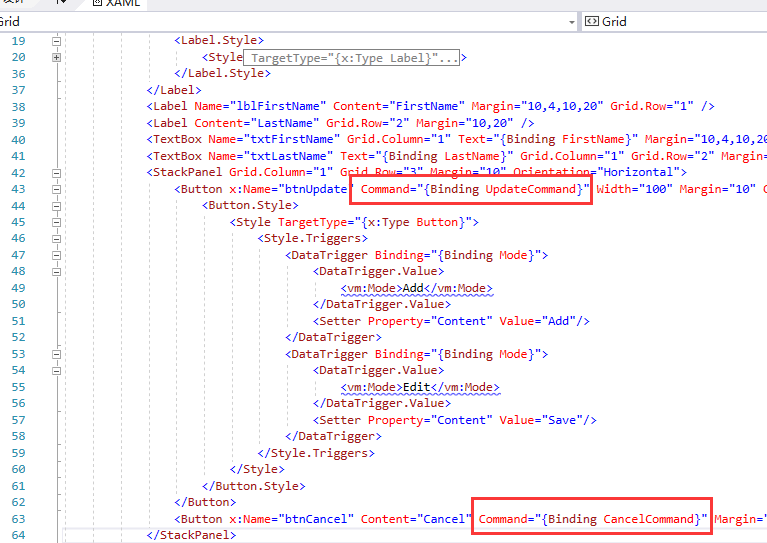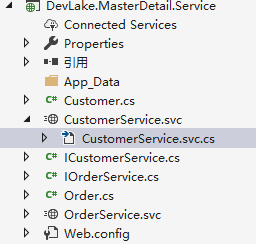概要
该演示项目利用WPF应用程序构建的MVVM架构示例, 运用了Unity容器接口注入, MVVM的经典设计, 后台利用的EF+WCF。
后台实现:
从数据库生成的emdx 结合上下文进行数据交互, 服务以WCF发布:
public class FactoryManager { private IDataManager dataManager; public FactoryManager() { //can easily switch to other providers in the future without changing client code dataManager = new EntityFrameworkManager(); } public ICustomerManager GetCustomerManager() { return dataManager.GetCustomerManager(); } public IOrderManager GetOrderManager() { return dataManager.GetOrderManager(); } }
class EntityFrameworkManager : IDataManager { ICustomerManager IDataManager.GetCustomerManager() { return new CustomerManager(); } IOrderManager IDataManager.GetOrderManager() { return new OrderManager(); } class CustomerManager : ICustomerManager { int ICustomerManager.Add(string firstName, string lastName) { using (var context = new MasterDetailEntities()) { Customer c = new Customer { FirstName = firstName, LastName = lastName }; context.Customers.AddObject(c); context.SaveChanges(); return c.CustomerId; } } void ICustomerManager.Delete(int customerId) { using (var context = new MasterDetailEntities()) { Customer c = context.Customers.Where(i => i.CustomerId == customerId).First(); context.DeleteObject(c); context.SaveChanges(); } } void ICustomerManager.Update(int customerId, string firstName, string lastName) { using (var context = new MasterDetailEntities()) { Customer c = context.Customers.Where(i => i.CustomerId == customerId).First(); c.FirstName = firstName; c.LastName = lastName; context.SaveChanges(); } } List<Customer> ICustomerManager.FindAll() { using (var context = new MasterDetailEntities()) { return context.Customers.ToList(); } } Customer ICustomerManager.FindByOrder(int orderId) { using (var context = new MasterDetailEntities()) { return context.Orders.Where(i => i.OrderId == orderId).First().Customer; } } } class OrderManager : IOrderManager { int IOrderManager.Add(string description, int quantity, int customerId) { using (var context = new MasterDetailEntities()) { Order order = new Order { Description = description, Quantity = quantity }; context.Customers.First(i => i.CustomerId == customerId).Orders.Add(order); context.SaveChanges(); return order.OrderId; } } void IOrderManager.Delete(int orderId) { using (var context = new MasterDetailEntities()) { Order a = context.Orders.Where(i => i.OrderId == orderId).First(); context.DeleteObject(a); context.SaveChanges(); } } void IOrderManager.Update(int orderId, string description, int quantity) { using (var context = new MasterDetailEntities()) { Order a = context.Orders.Where(i => i.OrderId == orderId).First(); a.Description = description; a.Quantity = quantity; context.SaveChanges(); } } List<Order> IOrderManager.FindByCustomer(int customerId) { using (var context = new MasterDetailEntities()) { return context.Customers.First(i => i.CustomerId == customerId).Orders.ToList(); } } Order IOrderManager.Find(int orderId) { using (var context = new MasterDetailEntities()) { return context.Orders.First(i => i.OrderId == orderId); } } } }
WCF服务:
部分wcf接口实现:
[ServiceContract] public interface ICustomerService { [OperationContract] List<Customer> GetCustomers(); [OperationContract] int AddCustomer(string FirstName, string LastName); [OperationContract] void UpdateCustomer(Customer c); [OperationContract] void DeleteCustomer(int customerId); }
public class CustomerService : ICustomerService { List<Customer> ICustomerService.GetCustomers() { List<Customer> result = new List<Customer>(); foreach (Business.Customer i in Business.CustomerManager.Instance().CustomerList) result.Add(new Customer(i)); return result; } int ICustomerService.AddCustomer(string firstName, string lastName) { return Business.CustomerManager.Instance().AddCustomer(firstName, lastName); } void ICustomerService.UpdateCustomer(Customer c) { Business.CustomerManager.Instance().UpdateCustomer(new Business.Customer(c.CustomerId, c.FirstName, c.LastName)); } void ICustomerService.DeleteCustomer(int customerId) { Business.CustomerManager.Instance().DeleteCustomer(customerId); } }
Unity实现:
接口及实现:
public interface IServiceLocator { void Register<TInterface, TImplementation>() where TImplementation : TInterface; TInterface Get<TInterface>(); }
class UnityServiceLocator : IServiceLocator { private UnityContainer container; public UnityServiceLocator() { container = new UnityContainer(); } void IServiceLocator.Register<TInterface, TImplementation>() { container.RegisterType<TInterface, TImplementation>(); } TInterface IServiceLocator.Get<TInterface>() { return container.Resolve<TInterface>(); } }
全局静态类
class ServiceProvider { public static IServiceLocator Instance { get; private set; } public static void RegisterServiceLocator(IServiceLocator s) { Instance = s; } }
进行Unitity容器接口注入:
//initialize all the services needed for dependency injection //we use the unity framework for dependency injection, but you can choose others ServiceProvider.RegisterServiceLocator(new UnityServiceLocator()); //register the IModalDialog using an instance of the CustomerViewDialog //this sets up the view ServiceProvider.Instance.Register<IModalDialog, CustomerViewDialog>();
ViewModel 模块操作进行Unitity容器获取接口实例(红色实现部分)
private void ShowAddDialog() { CustomerViewModel customer = new CustomerViewModel(); customer.Mode = Mode.Add; IModalDialog dialog = ServiceProvider.Instance.Get<IModalDialog>(); dialog.BindViewModel(customer); dialog.ShowDialog(); }
MVVM DataContext关联ViewModel:
通过DataContext关联模块的ViewModel层实现所有的操作。
this.DataContext= xxViewModel;
view页面:

ViewModel部分绑定实现:
所有的ViewModel统一实现ViewModelBase 接口, 进行属性通知。
public ICommand UpdateCommand { get { if (updateCommand == null) { updateCommand = new CommandBase(i => this.Update(), null); } return updateCommand; } } public ICommand DeleteCommand { get { if (deleteCommand == null) { deleteCommand = new CommandBase(i => this.Delete(), null); } return deleteCommand; } }
